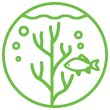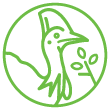Marine parks and fish habitat areas
Key Finding
About 18%, or 1.893 million hectares, of Queensland’s total marine wetlands are in highly protected marine park zones or declared fish habitat areas.
Marine wetlands include the area of ocean from the coastline to 6 metres below the lowest astronomical tide.
Of the 11 million hectares (ha) of marine wetlands within Queensland waters, about 1.893 million hectares (18%) are within a highly protected marine park zone or a declared fish habitat area.
- Highly protected marine park zones account for most of the protected marine wetlands, totalling 1.6 million hectares (83%).
- About 1.184 million hectares, or 76%, of that total is zoned as marine national park, with much of the remainder in conservation park zoning (22%).
Marine wetlands in declared fish habitat areas account for more than 436,900ha, or 23% of the total protected marine wetlands.
* Figures provided are rounded to the nearest 100ha.
Disclaimer: The State of the Environment report 2020 (SoE2020) wetlands statistics are not comparable with previous SoE report figures. The SoE2020 statistics are based on the most recently available wetlands and other updated data. The different versions of the wetlands mapping (e.g. 2017 – v4; 2020 – v5) and other datasets are not comparable due to a number of factors such as updated source data, improved data capture methods. Therefore differences between SoE reports do not reflect an actual wetland extent change on-ground and only statistics within each SoE report should be compared.
More information:
Relevant Sustainable Development Goals’ targets
Download data from Queensland Government data
Metadata
The proportion of marine wetlands that are within: Areas of Fish Habitat under the Fisheries Act 2008 and State Marine Parks (Highly Protected Zones) under the Marine Parks Act 2004. Data is based on the latest Queensland Wetland Mapping (version 5, 2017) and the most current Fish habitat and Marine Parks mapping (2020).






